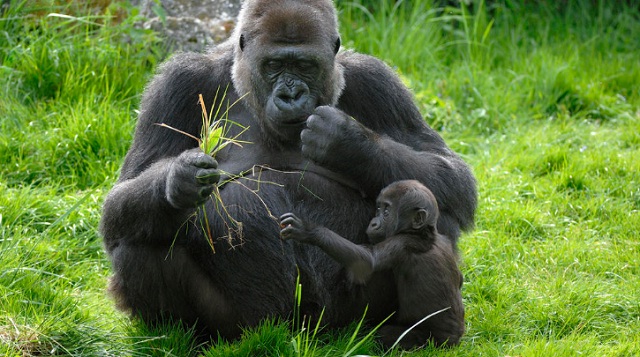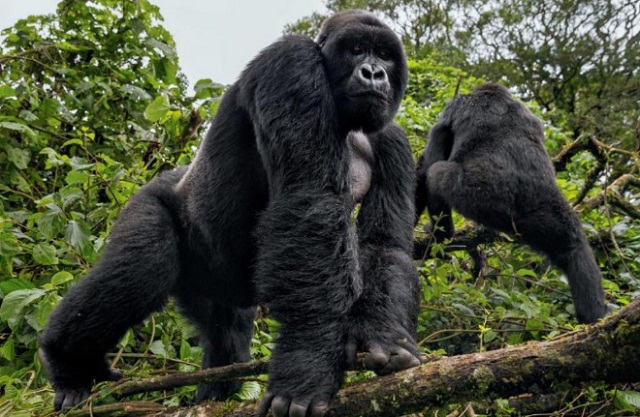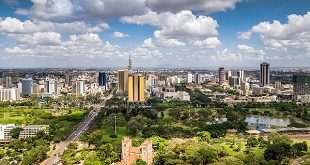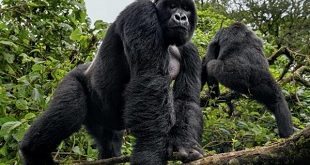
Targets more from growing population of tourism magnet
Kampala, Uganda | FRANCIS BYARUHANGA | Rwanda has got a new additional habitat for its growing population of rare mountain gorillas, the Gorilla Berengei Berengei.
The 27.8-hectare property (about the size of 70 standard football fields, was donated by the AWF (African Wildlife Fund) and will be incorporated into the 16,000 hectare gorilla habitat of the Volcanoes National Park in Kinigi, Northern Province.
Volcanoes National park is one of the Africa’s oldest national parks. It is part of what was formerly called the Albert National park, which was established in 1925 and comprised the highest protected areas located in the greater Virunga Trans Boundary Landscape, part of the Albertine region, in Rwanda, Uganda, and the DR Congo.
The region is one of the most ecologically significant ecosystems in the world in terms of species diversity and endemism.
The Minister of Industry and Trade, Vincent Munyeshyaka, said more land to the parks will add value on its importance and national parks in Rwanda and contribute greatly to the national economy through eco-tourism.
“In fact, for the last six consecutive years, tourism has become the number one foreign currency earner, and the Volcanoes National parks has been a contributor,” he said.
To illustrate, he said volcanoes National Park in 2016 received 32,818 visitors who directly generated US$16 million, while between 2007 and 2016, Volcanoes National Park generated over US$115 million.
Since 2006, over 298,000 tourists have visited the Volcanoes National Park. An average number of 29,000 tourists have visited the Park between 2011 and 2016.
Munyeshyaka said communities around the park have also benefited directly from more than 40% of its total contribution and this has been achieved through support provided by Rwanda development Board (RDB).
Rwanda praised
Clare Akamanzi, the Chief Executive Officer of RDB which is in charge of the habitats, said despite its extraordinary biodiversity, the Volcanoes National Park, on the Rwandan side of the Virunga Massif, is relatively small, covering only 160km2 which results in Mountain Gorilla’s leaving the park, causing conflict with farmers and making themselves vulnerable to diseases which is the greatest threats to this endangered species.
Speaking during the handover ceremony in Kinigi, Akamanzi said the AWF donation is a major step in the consolidation of Rwanda’s conservation gains.
She described how Rwanda was already gaining from the tourism supported by the gorilla conservation. She said, over the last nine years, up to US$ 107 million have gone to the national coffers revenues from the mountain gorilla conservation and the resulting tourism.
Akamanzi also revealed that over Rwf 531,466,921 was distributed by RDB to more than 158 community-based projects through the revenue sharing program.

“This support will increase this year following the Government’s decision in 2017, to increase the revenue sharing program from 5% to 10% of all tourism revenues,” she said.
In addition, in partnership with fellow conservationists, over 731 community based projects, with an estimated value of US$6.1 million have been set up to provide housing, schools, health clinics and water tanks for the community living in the 45 sectors and 12 Districts surrounding Akagera, Nyungwe, and Volcanoes National Parks, she said.
The AWF President, Kaddu Sebunya, praised Rwanda for having distinguished itself as a leader in conservation because of the most remarkable recovery of the great apes. He said Rwanda and RDB had provided a template for sustainable development.
He said through its proactive government policies, community involvement and open governance, Rwanda is demonstrating that development and conservation are not mutually exclusive.
“I am excited by the great strides Rwanda is taking to develop its natural heritage sustainably and guarantee long-term socio-economic stability for its people,” he said, “Such a win-win approach to conservation suggests that there is nothing inevitable about conservation challenges in Africa today.”
Sebunya said AWF recognises that if mountain gorillas are going to survive in the long-term, the Volcanoes National Park must be strategically protected. Therefore, he said, AWF is committed to supporting RDB in this endeavor.
He said AWF, with support from the Annenberg Foundation, bought the 27.8 hectares of land directly adjacent to the Park to donate to the Government of Rwanda to be incorporated into the Park.
Tackling challenges
The rare mountain Gorilla, which is listed as `critically endangered’ by the International Union for Conservation of Nature, is found in only two location in the world. One location straddles the Virunga mountain ranges in Rwanda, the DR Congo, and Uganda. The other is in the Bwindi Impenetrable Forests of Uganda. Most estimates say there are less than 1000 of the primates today and there has been concerted effort protect them; especially by conserving their habitat.
According to the last census of 2010 by the Rwanda Development Board (RDB), the Virunga Massif which includes three national parks; namely the Volcanic National Park in Rwanda, The Virunga South National Park in the DR Congo, and the Mgahinga Gorrilla National Park in Uganda, with an area covering 450km2, hosts 480 gorillas. This represents an increase of 26.3% over the previous seven years, or an average growth rate of 3.7% per annum.
The Volcanoes National Park on the Rwanda side, has registered the biggest success in the effort. Estimates claim that the habitat had decreased by 54% since its establishment in 1925.
Due to conservation efforts by the Government of Rwanda, as well as its conservation partners, mountain gorilla numbers are recovering. The population has increased from a low of 285 in 1978 to 480 in 2010. Between 2003 and 2010, gorilla numbers have increased by 26.3%. This represents an annual growth rate of 3.7%.
The increase in Rwanda’s mountain gorilla population has led to a major challenge; the provision of adequate habitat.
 The Independent Uganda: You get the Truth we Pay the Price
The Independent Uganda: You get the Truth we Pay the Price



